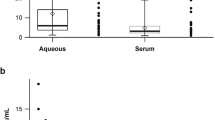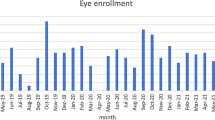Abstract
Aim
To determine the anatomical and functional outcome after injection of bevacizumab (Avastin, Genentech) in eyes with retinal angiomatous proliferation (RAP).
Design
Prospective interventional case series.
Methods
Sixteen eyes of 16 consecutive patients with visual loss due to RAP underwent intravitreal injections of 1.25 mg (0.05 ml) bevacizumab. Best corrected visual acuity testing, fluorescein and ICG-angiography as well as OCT imaging were performed at baseline and at each follow-up visit within a 3-month period.
Results
Mean visual acuity pre-injection was 0.68 ± 0.36 logMAR (n = 16), mean reading ability 0.58 ± 0.26 logRAD (n = 11). Far vision increased significantly by a mean of 1.7 ± 2 lines 4 weeks after the injection (p = 0.004), as did reading (0.6 ± 2.3 lines, p > 0.05). Both remained stable up to 3 months. Central retinal thickness decreased from 367 ± 112 μm (mean±SD) to 272 ± 123 μm 3 months after injection (p = 0.006). Leakage decreased angiographically in 12 eyes (75%) and remained stable in four eyes (25%). Re-injection of bevacizumab within the 3-month follow-up period was performed once in eight eyes, and twice in one eye. No adverse events were observed.
Conclusion
Intravitreal bevacizumab (Avastin) resulted in a reduction of leakage, intra- and subretinal fluid. An increase in visual acuity was seen already 4 weeks after first injection. However, a complete occlusion of feeder vessels could not be achieved within this 3-month period. Randomized clinical trials would be required to evaluate dose and frequency of injections and possible beneficial effects of combination therapies, as well as the long-term results.




Similar content being viewed by others
References
Kuhn D, Meunier I, Soubrane G et al (1995) Imaging of chorioretinal anastomoses in vascularized retinal pigment epithelium detachments. Arch Ophthalmol 11:1392–1398
Boscia F, Furino C, Sborgia L et al (2004) Photodynamic therapy for retinal angiomatous proliferations and pigment epithelium detachment. Am J Ophthalmol 138:1077–1079
Nicolo M, Ghiglione D, Lai S et al (2006) Retinal angiomatous proliferation treated by intravitreal triamcinolone and photodynamic therapy with verteporfin. Graefes Arch Clin Exp Ophthalmol 244:1336–1338
Bottoni F, Romano M, Massacesi A et al (2006) Remodeling of the vascular channels in retinal angiomatous proliferations treated with intravitreal triamcinolone acetonide and photodynamic therapy. Graefes Arch Clin Exp Ophthalmol 244:1528–1533
Freund KB, Klais CM, Eandi CM et al (2006) Sequenced combined intravitreal triamcinolone and indocyanine green angiography-guided photodynamic therapy for retinal angiomatous proliferation. Arch Ophthalmol 124:487–492
Smithen LM, Ober MD, Maranan L et al (2004) Intravitreal triamcinolone acetonide and intraocular pressure. Am J Ophthalmol 138:740–743
Jonas J, Heatley G, Spaide R et al (2005) Intravitreal triamcinolone acetonide and secondary ocular hypertension. J Glaucoma 14:168–171
Gragoudas ES, Adamis AP, Cunningham ET Jr et al (2004) VEGF Inhibition Study in Ocular Neovascularization Clinical Trial Group. Pegaptanib for neovascular age-related macular degeneration. N Engl J Med 351:2805–2816
Medienmitteilung Novartis. Preliminary data from second pivotal Phase III study showed Lucentis maintained or improved vision in 95 percent of patients with age-related macular degeneration. Basel, 7. November 2005
Spaide RF, Laud K, Fine HF et al (2006) Intravitreal bevacizumab treatment of choroidal neovascularization secondary to age-related macular degeneration. Retina 26:383–390
Yannuzzi LA, Negrao S, Iida T et al (2001) Retinal angiomatous proliferation in age-related macular degeneration. Retina 21:416–434
Radner W, Willinger U, Obermayer W et al (1998) Eine neue Lesetafel zur gleichzeitigen Bestimmung von Lesevisus und Lesegeschwindigkeit. Klin Monatsbl Augenheilkd 213:174–181
Stifter E, Konig F, Lang T et al (2004) Reliability of a standardized reading chart system: variance component analysis, test-retest and inter-chart reliability. Graefes Arch Clin Exp Ophthalmol 242:31–39
Schachat AP, Chambers WA, Liesegang TJ, Albert DA (2003) Safe and effective. Ophthalmology 110:2073–2074
Slakter JS, Yannuzzi LA, Schneider U et al (2000) Retinal choroidal anastomoses and occult choroidal neovascularization in age-related macular degeneration. Ophthalmology 107:742–753
Klais CM, Eandi CM, Ober MD et al (2006) Anecortave acetate treatment for retinal angiomatous proliferation: a pilot study. Retina 26:773–779
Lafaut BA, Aisenbrey S, Vanden Broecke C et al (2000) Clinicopathological correlation of deep retinal vascular anomalous complex in age related macular degeneration. Br J Ophthalmol 84(11):1269–1274
Strauss O (2005) The retinal pigment epithelium in visual function. Physiol Rev 85:845–881
Blaauwgeers HG, Holtkamp GM, Rutten H et al (1999) Polarized vascular endothelial growth factor secretion by human retinal pigment epithelium and localization of vascular endothelial growth factor receptors on the inner choriocapillaris. Evidence for a trophic paracrine relation. Am J Pathol 155:421–428
Jablonski MM, Tombran-Tink J, Mrazek DA et al (2001) Pigment epithelium derived factor supports normal Muller cell development and glutamine synthetase expression after removal of the retinal pigment epithelium. Glia 35:14–25
Becerra SP, Fariss RN, Wu YQ et al (2004) Pigment epithelium-derived factor in the monkey retinal pigment epithelium and interphotoreceptor matrix: apical secretion and distribution. Exp Eye Res 78:223–234
Acknowledgements
The authors thank Beate Prinz and Erica Menrath for expert technical assistance. PD Dr. K. Lucke, Bremen supplied data from two of his patients.
Author information
Authors and Affiliations
Corresponding author
Rights and permissions
About this article
Cite this article
Joeres, S., Heussen, F.M.A., Treziak, T. et al. Bevacizumab (Avastin) treatment in patients with retinal angiomatous proliferation. Graefes Arch Clin Exp Ophthalmol 245, 1597–1602 (2007). https://doi.org/10.1007/s00417-007-0580-y
Received:
Revised:
Accepted:
Published:
Issue Date:
DOI: https://doi.org/10.1007/s00417-007-0580-y




